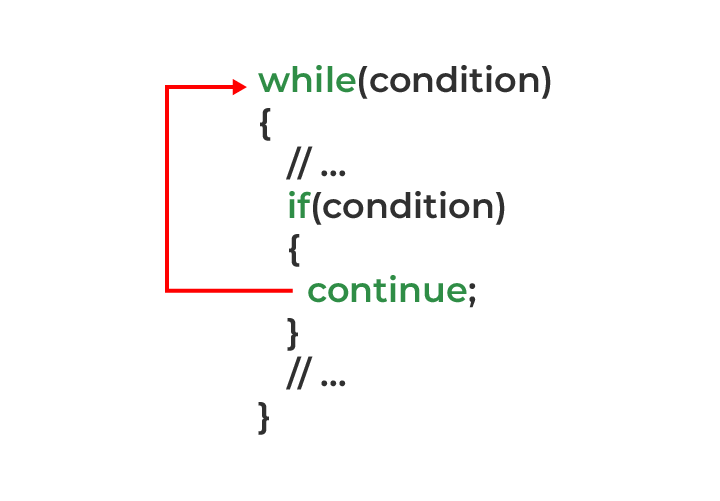continue Statement in C++
Last Updated :
04 Jan, 2023
C++ continue statement is a loop control statement that forces the program control to execute the next iteration of the loop. As a result, the code inside the loop following the continue statement will be skipped and the next iteration of the loop will begin.
Syntax:
continue;

Flowchart of continue Statement in C++
Example: Consider the situation when you need to write a program that prints numbers from 1 to 10 but not 4. It is specified that you have to do this using loop and only one loop is allowed to use. Here comes the usage of the continue statement. What we can do here is we can run a loop from 1 to 10 and every time we have to compare the value of the iterator with 4. If it is equal to 4 we will use the continue statement to continue to the next iteration without printing anything otherwise we will print the value.
Continue Statement with for Loop
If continue is used in a for loop, the control flow jumps to the test expression after skipping the current iteration.

Continue statement in for loop
Example:
C++
#include <iostream>
using namespace std;
int main()
{
for (int i = 1; i <= 10; i++) {
if (i == 4)
continue;
else
cout << i << " ";
}
return 0;
}
|
Output
1 2 3 5 6 7 8 9 10
The continue statement can be used with any other loop also like while or do while in a similar way as it is used with for loop above.
Continue Statement with While Loop
With continue, the current iteration of the loop is skipped, and control flow resumes in the next iteration of while loop.

The continue statement in while loop
Example:
C++
#include <iostream>
using namespace std;
int main()
{
int i = 0;
while (i < 10) {
i++;
if (i == 4) {
continue;
}
else {
cout << i << " ";
}
}
return 0;
}
|
Output
1 2 3 5 6 7 8 9 10
Continue Statement with do-while Loop
In do-while loop, the condition is checked after executing the loop body. When a continue statement is encountered in the do-while loop, the control jumps directly to the condition checking for the next loop, and the remaining code in the loop body is skipped.
.png)
The continue statement in do-while loop
Example:
C++
#include <iostream>
using namespace std;
int main()
{
int i = 0;
do {
i++;
if (i == 4) {
continue;
}
else {
cout << i << ' ';
}
} while (i < 10);
return 0;
}
|
Output
1 2 3 5 6 7 8 9 10
Here, 4 is not printed as a continue statement is encountered in the case of i = 4.
Note: In while and do-while loop, we updated the loop variable i before the continue statement or else we will keep encountering continue before updating the loop variable creating an infinite loop.
Continue Statement with Nested Loops
Using continue, you skip the current iteration of the inner loop when using nested loops.
Example:
C++
#include <iostream>
using namespace std;
int main()
{
for (int i = 1; i <= 2; i++) {
for (int j = 0; j <= 4; j++) {
if (j == 2) {
continue;
}
cout << j << " ";
}
cout << endl;
}
return 0;
}
|
Continue skips the current iteration of the inner loop when it executes in the above program. As a result, the program is controlled by the inner loop update expression. In this way, 2 is never displayed in the output.
Continue Statement vs Break Statement
There are some differences between the continue and break statements which alter the normal flow of a program.
| Continue |
Break |
| Only the current loop iteration is stopped by a Continue statement. |
The break statement stops the loop in its entirety. |
| With Continue, subsequent iterations continue without interruption. |
The remaining iterations are also terminated by Break. |
| Continue statement can be used with for loop but it cannot be used with switch statements |
The break statement can be used with the switch statement |
| When you use the continue statement, and the control statements, the control remains inside the loop. |
When you use a break statement, the control exits from the loop. |
| The continue statement skips a particular loop iteration. |
The execution of the loop at a specific condition is stopped with a break statement. |
Exercise Problem: Given a number n, print a triangular pattern. We are allowed to use only one loop.
Input: 7
Output:
*
* *
* * *
* * * *
* * * * *
* * * * * *
* * * * * * *
Solution: Print the pattern by using one loop | Set 2 (Using Continue Statement)
Share your thoughts in the comments
Please Login to comment...